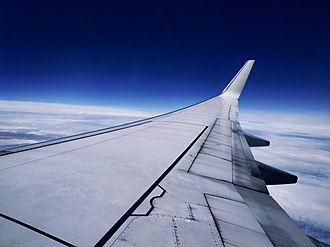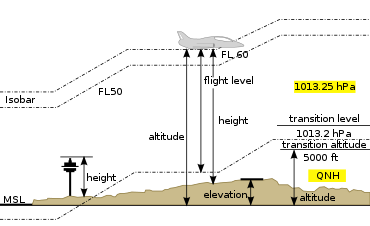Altitude

Altitudeis a distance measurement, usually in the vertical or "up" direction, between a referencedatumand a point or object. The exact definition and reference datum varies according to the context (e.g., aviation, geometry, geographical survey, sport, or atmospheric pressure). Although the termaltitudeis commonly used to mean theheight above sea levelof a location, ingeographythe termelevationis often preferred for this usage.
Vertical distance measurements in the "down" direction are commonly referred to asdepth.
In aviation[edit]
This sectionneeds additional citations forverification.(December 2018) |


The term altitude can have several meanings, and is always qualified by explicitly adding a modifier (e.g. "true altitude" ), or implicitly through the context of the communication. Parties exchanging altitude information must be clear which definition is being used.
Aviation altitude is measured using eithermean sea level(MSL) or local ground level (above ground level, or AGL) as the reference datum.
Pressure altitudedivided by 100 feet (30 m) is theflight level,and is used above thetransition altitude(18,000 feet (5,500 m) in the US, but may be as low as 3,000 feet (910 m) in other jurisdictions). So when the altimeter reads the country-specific flight level on the standard pressure setting the aircraft is said to be at "Flight level XXX/100" (where XXX is the transition altitude). When flying at a flight level, the altimeter is always set to standard pressure (29.92inHgor 1013.25hPa).
On the flight deck, the definitive instrument for measuring altitude is the pressurealtimeter,which is ananeroid barometerwith a front face indicating distance (feet or metres) instead ofatmospheric pressure.
There are several types of altitude in aviation:
- Indicated altitudeis the reading on the altimeter when it is set to thelocal barometric pressure at mean sea level.In UK aviation radiotelephony usage,the vertical distance of a level, a point or an object considered as a point, measured from mean sea level;this is referred to over the radio asaltitude.(seeQNH)[2]
- Absolute altitudeis the vertical distance of the aircraft above the terrain over which it is flying.[3]: ii It can be measured using aradar altimeter(or "absolute altimeter" ).[3]Also referred to as "radar height" or feet/metresabove ground level(AGL).
- True altitudeis the actual elevation abovemean sea level.[3]: ii It is indicated altitude corrected for non-standard temperature and pressure.
- Heightis the vertical distance above a reference point, commonly the terrain elevation. In UK aviation radiotelephony usage,the vertical distance of a level, a point or an object considered as a point, measured from a specified datum;this is referred to over the radio asheight,where the specified datum is the airfield elevation (seeQFE)[2]
- Pressure altitudeis the elevation above a standard datum air-pressure plane (typically, 1013.25 millibars or 29.92 "Hg). Pressure altitude is used to indicate" flight level "which is the standard for altitude reporting in the U.S. in Class A airspace (above roughly 18,000 feet). Pressure altitude and indicated altitude are the same when the altimeter setting is 29.92" Hg or 1013.25 millibars.
- Density altitudeis the altitude corrected for non-ISAInternational Standard Atmosphereatmospheric conditions. Aircraft performance depends on density altitude, which is affected by barometric pressure, humidity and temperature. On a very hot day, density altitude at an airport (especially one at a high elevation) may be so high as to preclude takeoff, particularly for helicopters or a heavily loaded aircraft.
These types of altitude can be explained more simply as various ways of measuring the altitude:
- Indicated altitude– the altitude shown on the altimeter.
- Absolute altitude– altitude in terms of the distance above the ground directly below
- True altitude– altitude in terms of elevation above sea level
- Height– vertical distance above a certain point
- Pressure altitude– theair pressurein terms of altitude in the International Standard Atmosphere
- Density altitude– the density of the air in terms of altitude in the International Standard Atmosphere in the air
In satellite orbits[edit]

- Transatmospheric orbit(TAO)
- Geocentric orbits with altitudes atapogeehigher than 100 km (62 mi) andperigeethat intersects with thedefined atmosphere.[4]
- Low Earth orbit(LEO)
- Geocentric orbits ranging in altitude from 160 km (100 mi) to 2,000 km (1,200 mi) abovemean sea level.At 160 km, one revolution takes approximately 90 minutes, and the circular orbital speed is 8 km/s (26,000 ft/s).
- Medium Earth orbit(MEO)
- Geocentric orbits with altitudes at apogee ranging between 2,000 km (1,200 mi) and that of thegeosynchronous orbitat 35,786 km (22,236 mi).
- Geosynchronous orbit(GEO)
- Geocentric circular orbit with an altitude of 35,786 km (22,236 mi). The period of the orbit equals onesidereal day,coinciding with the rotation period of the Earth. The speed is approximately 3 km/s (9,800 ft/s).
- High Earth orbit(HEO)
- Geocentric orbits with altitudes at apogee higher than that of the geosynchronous orbit. A special case of high Earth orbit is thehighly elliptical orbit,where altitude at perigee is less than 2,000 km (1,200 mi).[5]
In atmospheric studies[edit]
Atmospheric layers[edit]
TheEarth's atmosphereis divided into several altitude regions. These regions start and finish at varying heights depending on season and distance from the poles. The altitudes stated below are averages:[6]
- Troposphere:surface to 8,000 metres (5.0 mi) at the poles, 18,000 metres (11 mi) at theEquator,ending at the Tropopause
- Stratosphere:Troposphere to 50 kilometres (31 mi)
- Mesosphere:Stratosphere to 85 kilometres (53 mi)
- Thermosphere:Mesosphere to 675 kilometres (419 mi)
- Exosphere:Thermosphere to 10,000 kilometres (6,200 mi)
TheKármán line,at an altitude of 100 kilometres (62 mi) abovesea level,by convention defines represents the demarcation between the atmosphere andspace.[7]The thermosphere and exosphere (along with the higher parts of the mesosphere) are regions of the atmosphere that are conventionally defined as space.
High altitude and low pressure[edit]
Regions on theEarth's surface (or in its atmosphere) that are high above mean sea level are referred to ashigh altitude.High altitude is sometimes defined to begin at 2,400 meters (8,000 ft) above sea level.[8][9][10]
At high altitude,atmospheric pressureis lower than that at sea level. This is due to two competing physical effects: gravity, which causes the air to be as close as possible to the ground; and the heat content of the air, which causes the molecules to bounce off each other and expand.[11]
Temperature profile[edit]
The temperature profile of the atmosphere is a result of an interaction betweenradiationandconvection.Sunlight in thevisible spectrumhits the ground and heats it. The ground then heats the air at the surface. Ifradiationwere the only way to transfer heat from the ground to space, thegreenhouse effectof gases in the atmosphere would keep the ground at roughly 333 K (60 °C; 140 °F), and the temperature would decay exponentially with height.[12]
However, when air is hot, it tends to expand, which lowers its density. Thus, hot air tends to rise and transfer heat upward. This is the process ofconvection.Convection comes to equilibrium when a parcel of air at a given altitude has the same density as its surroundings. Air is a poor conductor of heat, so a parcel of air will rise and fall without exchanging heat. This is known as anadiabatic process,which has a characteristic pressure-temperature curve. As the pressure gets lower, the temperature decreases. The rate of decrease of temperature with elevation is known as theadiabatic lapse rate,which is approximately 9.8 °C per kilometer (or 5.4 °F [3.0 °C] per 1000 feet) of altitude.[12]
The presence of water in the atmosphere complicates the process of convection. Water vapor contains latentheat of vaporization.As air rises and cools, it eventually becomessaturatedand cannot hold its quantity of water vapor. The water vapor condenses (formingclouds), and releases heat, which changes the lapse rate from thedry adiabatic lapse rateto themoist adiabatic lapse rate(5.5 °C per kilometer or 3 °F [1.7 °C] per 1000 feet).[13] As an average, the International Civil Aviation Organization (ICAO) defines aninternational standard atmosphere(ISA) with a temperaturelapse rateof 6.49 °C per kilometer (3.56 °F per 1,000 feet).[14]The actual lapse rate can vary by altitude and by location.
Finally, only thetroposphere(up to approximately 11 kilometres (36,000 ft) of altitude) in the Earth's atmosphere undergoes notable convection; in thestratosphere,there is little vertical convection.[15]
Effects on organisms[edit]
Humans[edit]
Medicine recognizes that altitudes above 1,500 metres (4,900 ft) start to affect humans,[16]and there is no record of humans living at extreme altitudes above 5,500–6,000 metres (18,000–19,700 ft) for more than two years.[17]As the altitude increases, atmospheric pressure decreases, which affects humans by reducing thepartial pressureofoxygen.[18]The lack of oxygen above 2,400 metres (8,000 ft) can cause serious illnesses such asaltitude sickness,high altitude pulmonary edema,andhigh altitude cerebral edema.[10]The higher the altitude, the more likely are serious effects.[10]The human body canadapt to high altitudeby breathing faster, having a higher heart rate, and adjusting its blood chemistry.[19][20]It can take days or weeks to adapt to high altitude. However, above 8,000 metres (26,000 ft), (in the "death zone"), altitude acclimatization becomes impossible.[21]
There is a significantly lower overall mortality rate for permanent residents at higher altitudes.[22]Additionally, there is a dose response relationship between increasing elevation and decreasing obesity prevalence in the United States.[23]In addition, the recent hypothesis suggests that high altitude could be protective against Alzheimer's disease via action of erythropoietin, a hormone released by kidney in response to hypoxia.[24] However, people living at higher elevations have a statistically significant higher rate of suicide.[25]The cause for the increased suicide risk is unknown so far.[25]
Athletes[edit]
For athletes, high altitude produces two contradictory effects on performance. For explosive events (sprints up to 400 metres,long jump,triple jump) the reduction in atmospheric pressure signifies less atmospheric resistance, which generally results in improved athletic performance.[26]For endurance events (races of 5,000 metres or more) the predominant effect is the reduction in oxygen which generally reduces the athlete's performance at high altitude. Sports organizations acknowledge the effects of altitude on performance: the International Association of Athletic Federations (IAAF), for example, marks record performances achieved at an altitude greater than 1,000 metres (3,300 ft) with the letter "A".[27]
Athletes also can take advantage of altitude acclimatization to increase their performance. The same changes that help the body cope with high altitude increase performance back at sea level.[28][29]These changes are the basis ofaltitude trainingwhich forms an integral part of the training of athletes in a number of endurance sports including track and field, distance running, triathlon, cycling and swimming.
Other organisms[edit]
Decreased oxygen availability and decreased temperature make life at high altitude challenging. Despite these environmental conditions, many species have been successfullyadapted at high altitudes.Animals have developed physiological adaptations to enhance oxygen uptake and delivery to tissues which can be used to sustain metabolism. The strategies used by animals to adapt to high altitude depend on theirmorphologyandphylogeny.For example, small mammals face the challenge of maintaining body heat in cold temperatures, due to their small volume to surface area ratio. As oxygen is used as a source of metabolic heat production, the hypobaric hypoxia at high altitudes is problematic.
There is also a general trend of smaller body sizes and lowerspecies richnessat high altitudes, likely due to lower oxygen partial pressures.[30]These factors may decreaseproductivityin high altitude habitats, meaning there will be less energy available for consumption, growth, and activity.[31]
However, some species, such as birds, thrive at high altitude.[32]Birds thrive because of physiological features that are advantageous for high-altitude flight.
See also[edit]
- Atmosphere of Earth
- Coffin corner (aerodynamics)At higher altitudes, the air density is lower than at sea level. At a certain altitude it is very difficult to keep an airplane in stable flight.
- Geocentric altitude
- Near space
References[edit]
- ^"The Stratosphere - overview".scied.ucar.edu.University Corporation for Atmospheric Research.Retrieved6 February2021.
- ^abRadiotelephony Manual.UK Civil Aviation Authority. 1 January 1995.ISBN978-0-86039-601-7.CAP413.
- ^abcAir Navigation.Department of the Air Force. 1 December 1989. AFM 51-40.
- ^McDowell, Jonathan (24 May 1998)."Jonathan's Space Report".
Transatmospheric orbit (TAO): orbital flight with perigee less than 80 km but more than zero. Potentially used by aerobraking missions and transatmospheric vehicles, also in some temporary phases of orbital flight (e.g. STS pre OMS-2, some failures when no apogee restart)
- ^Definitions of geocentric orbits from the Goddard Space Flight CenterArchivedMay 27, 2010, at theWayback Machine
- ^"Layers of the Atmosphere".JetStream, the National Weather Service Online Weather School.National Weather Service.Archivedfrom the original on 19 December 2005.Retrieved22 December2005.
- ^Dr. S. Sanz Fernández de Córdoba (24 June 2004)."The 100 km Boundary for Astronautics".Fédération Aéronautique Internationale.Archived fromthe originalon 9 August 2011.
- ^Webster's New World Medical Dictionary.Wiley. 2008.ISBN978-0-470-18928-3.Archived fromthe originalon 8 December 2011.Retrieved27 April2010.
- ^"An Altitude Tutorial".International Society for Mountain Medicine. Archived fromthe originalon 19 July 2011.Retrieved22 June2011.
- ^abcCymerman, A; Rock, PB (1994)."Medical Problems in High Mountain Environments. A Handbook for Medical Officers".USARIEM-TN94-2. U.S. Army Research Inst. of Environmental Medicine Thermal and Mountain Medicine Division Technical Report. Archived from the original on 23 April 2009.Retrieved5 March2009.
{{cite journal}}:Cite journal requires|journal=(help)CS1 maint: unfit URL (link) - ^"Atmospheric pressure".NOVA Online Everest.Public Broadcasting Service.Archivedfrom the original on 25 January 2009.Retrieved23 January2009.
- ^abGoody, Richard M.; Walker, James C.G. (1972)."Atmospheric Temperatures"(PDF).Atmospheres.Prentice-Hall. Archived fromthe original(PDF)on 29 July 2016.Retrieved2 May2016.
- ^"Dry Adiabatic Lapse Rate".tpub.com. Archived fromthe originalon 3 June 2016.Retrieved2 May2016.
- ^Manual of the ICAO Standard Atmosphere (extended to 80 kilometres (262 500 feet))(Third ed.).International Civil Aviation Organization.1993.ISBN978-92-9194-004-2.Doc 7488-CD.
- ^"The stratosphere: overview".UCAR.Retrieved2 May2016.
- ^"Non-Physician Altitude Tutorial".International Society for Mountain Medicine. Archived fromthe originalon 23 December 2005.Retrieved22 December2005.
- ^West, JB (2002). "Highest permanent human habitation".High Altitude Medical Biology.3(4): 401–407.doi:10.1089/15270290260512882.PMID12631426.
- ^Peacock, Andrew J (17 October 1998)."Oxygen at high altitude".British Medical Journal.317(7165): 1063–1066.doi:10.1136/bmj.317.7165.1063.PMC1114067.PMID9774298.
- ^Young, Andrew J.; Reeves, John T. (2002)."21".Human Adaptation to High Terrestrial Altitude. In: Medical Aspects of Harsh Environments.Vol. 2. Borden Institute, Washington, DC.Archivedfrom the original on 11 January 2009.
{{cite book}}:CS1 maint: location missing publisher (link) - ^Muza, SR; Fulco, CS; Cymerman, A (2004)."Altitude Acclimatization Guide".U.S. Army Research Inst. Of Environmental Medicine Thermal and Mountain Medicine Division Technical Report(USARIEM–TN–04–05). Archived from the original on 23 April 2009.Retrieved5 March2009.
{{cite journal}}:CS1 maint: unfit URL (link) - ^"Everest:The Death Zone".Nova.PBS. 24 February 1998.
- ^West, John B. (January 2011). "Exciting Times in the Study of Permanent Residents of High Altitude".High Altitude Medicine & Biology.12(1): 1.doi:10.1089/ham.2011.12101.PMID21452955.
- ^Voss, JD; Masuoka, P; Webber, BJ; Scher, AI; Atkinson, RL (2013)."Association of Elevation, Urbanization and Ambient Temperature with Obesity Prevalence in the United States".International Journal of Obesity.37(10): 1407–1412.doi:10.1038/ijo.2013.5.PMID23357956.
- ^Ismailov, RM (July–September 2013). "Erythropoietin and epidemiology of Alzheimer disease".Alzheimer Dis. Assoc. Disord.27(3): 204–6.doi:10.1097/WAD.0b013e31827b61b8.PMID23314061.S2CID32245379.
- ^abBrenner, Barry; Cheng, David; Clark, Sunday; Camargo, Carlos A. Jr (Spring 2011)."Positive Association between Altitude and Suicide in 2584 U.S. Counties".High Altitude Medicine & Biology.12(1): 31–5.doi:10.1089/ham.2010.1058.PMC3114154.PMID21214344.
- ^Ward-Smith, AJ (1983). "The influence of aerodynamic and biomechanical factors on long jump performance".Journal of Biomechanics.16(8): 655–658.doi:10.1016/0021-9290(83)90116-1.PMID6643537.
- ^"IAAF World Indoor Lists 2012"(PDF).IAAF Statistics Office. 9 March 2012. Archived fromthe original(PDF)on 22 October 2013.
- ^Wehrlin, JP; Zuest, P; Hallén, J; Marti, B (June 2006). "Live high—train low for 24 days increases hemoglobin mass and red cell volume in elite endurance athletes".J. Appl. Physiol.100(6): 1938–45.doi:10.1152/japplphysiol.01284.2005.PMID16497842.
- ^Gore, CJ; Clark, SA; Saunders, PU (September 2007)."Nonhematological mechanisms of improved sea-level performance after hypoxic exposure".Med Sci Sports Exerc.39(9): 1600–9.doi:10.1249/mss.0b013e3180de49d3.PMID17805094.
- ^Jacobsen, Dean (24 September 2007). "Low oxygen pressure as a driving factor for the altitudinal decline in taxon richness of stream macroinvertebrates".Oecologia.154(4): 795–807.Bibcode:2008Oecol.154..795J.doi:10.1007/s00442-007-0877-x.PMID17960424.S2CID484645.
- ^Rasmussen, Joseph B.; Robinson, Michael D.; Hontela, Alice; Heath, Daniel D. (8 July 2011)."Metabolic traits of westslope cutthroat trout, introduced rainbow trout and their hybrids in an ecotonal hybrid zone along an elevation gradient".Biological Journal of the Linnean Society.105:56–72.doi:10.1111/j.1095-8312.2011.01768.x.
- ^McCracken, K. G.; Barger, CP; Bulgarella, M; Johnson, KP; et al. (October 2009). "Parallel evolution in the major haemoglobin genes of eight species of Andean waterfowl".Molecular Evolution.18(19): 3992–4005.doi:10.1111/j.1365-294X.2009.04352.x.PMID19754505.S2CID16820157.
External links[edit]
- "Altitude pressure calculator".Apex (altitude physiology expeditions).Retrieved8 August2006.
- "The Race to the Stratosphere".U.S. Centennial of Flight Commission. Archived fromthe originalon 9 March 2006.Retrieved25 January2006.
- Downloadable ETOPO2 Raw Data Database (2 minute grid)
- Downloadable ETOPO5 Raw Data Database (5 minute grid)
